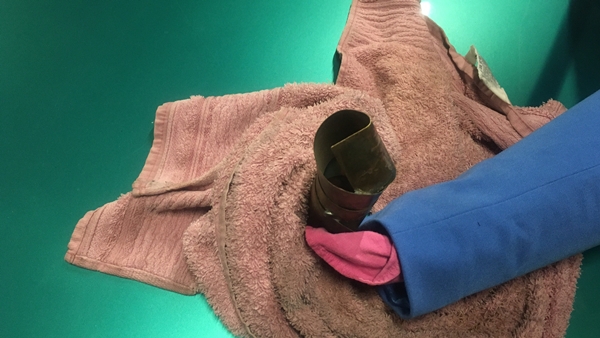"Night Engines"Caroline Mesquita

T293
Via Ripense 6, Roma, ItalyTel.+39 06 88980475 e-mail:


11 November > 8 December, 2017

On the occasion of a
recent show in Vevey (Switzerland), Caroline Mesquita went to
Gruyères to visit the house/ museum of HR Giger.
Controversial surrealist painter and
sculptor and best known for designing the anthropomorphic creature for 1979’s
‘
Alien
’
,
Giger is the author of
biomechanical creatures and extraterrestrial landscapes
characterized by a fascinating blend of erotic beaut
y and
brutality
.
The gloomy universe of
HR Giger, the fantastic series by Moebius and science fiction masterpieces such as
‘
Star
Wars
’ are for Caroline Mesquita
significant repertoires
of fantastic worlds and
characters.
Deeply
inspired by these
creations
, the metallurgical experiments of the young
French
artist
seem
to belong to another dimension and to an undefined time.
The human
size
of
her
sculptures
allow the artist and the spectator to establi
sh a more intimate,
physical
and sometimes
affective rela
tionship
with them
.
New forms
full
of tension and
energy are placed in particularly dynamic positions and then 'petrified' at the very
moment they are about to move, fall or take off.
‘ Night Engines ’ , Caroline Mesquita's first solo exhibition at T293, transforms the gallery into a sort of 'auto - show' populated by futuristic vehicles similar to original and bizarre spaceships . The desi re to create something that could not be reconnected to any familiar model and which was not underst andable from one single point of view required an intense preparatory work and numerous subsequent interventions. Caroline Mesquita uses metal for its intrinsic properties of brightness , malleab i lity and reaction that allow an immediate response from the m aterial . While in her recent projects the artist has mainly experimented brass and copper for their chromatic reactions to oxidation processes through chemicals, f or this exhibition Mesquita cho se to use the steel, most brilliant and resistant . In order to obtain light, sometimes soft volumes, the metals undergone complex manipulations through cuts, fol ds and welds. She often had to change the positions of the sculptures and even overturn them in order to get the right direction. During this prod uction, the artist acted more like an intermediary than an author, giving life to forms that needed to come to light.
The new creations , at the boundaries of reality and fiction , looks like singular and strangely beautiful extraterrestrial space ships , cur ious totems belonging to an unknown but t echnologically advanced culture recalling the provocative mechanical creations of Eduardo Paolozzi and the Spomenik , the futuristic and majestic monuments invading the countryside of the former Yugoslavia. Surrealist and oniric suggestions ispired , among others, by the vision and style of the movie director M. Night Shyamalan al so emerge in the video ‘ Night Engines ’ . The prot a gonist of the video, entirely shot at night, is a taxi driver who , in a full moon period, drives alone and meets with mysterious characters all played by the same actor: 'I like to change the identity of someone and to question genders, personality , sexuality, marginality, eccentricity. I like to imagine a more open sensu ality’. (C. Mes quita)
‘ Night Engines ’ , Caroline Mesquita's first solo exhibition at T293, transforms the gallery into a sort of 'auto - show' populated by futuristic vehicles similar to original and bizarre spaceships . The desi re to create something that could not be reconnected to any familiar model and which was not underst andable from one single point of view required an intense preparatory work and numerous subsequent interventions. Caroline Mesquita uses metal for its intrinsic properties of brightness , malleab i lity and reaction that allow an immediate response from the m aterial . While in her recent projects the artist has mainly experimented brass and copper for their chromatic reactions to oxidation processes through chemicals, f or this exhibition Mesquita cho se to use the steel, most brilliant and resistant . In order to obtain light, sometimes soft volumes, the metals undergone complex manipulations through cuts, fol ds and welds. She often had to change the positions of the sculptures and even overturn them in order to get the right direction. During this prod uction, the artist acted more like an intermediary than an author, giving life to forms that needed to come to light.
The new creations , at the boundaries of reality and fiction , looks like singular and strangely beautiful extraterrestrial space ships , cur ious totems belonging to an unknown but t echnologically advanced culture recalling the provocative mechanical creations of Eduardo Paolozzi and the Spomenik , the futuristic and majestic monuments invading the countryside of the former Yugoslavia. Surrealist and oniric suggestions ispired , among others, by the vision and style of the movie director M. Night Shyamalan al so emerge in the video ‘ Night Engines ’ . The prot a gonist of the video, entirely shot at night, is a taxi driver who , in a full moon period, drives alone and meets with mysterious characters all played by the same actor: 'I like to change the identity of someone and to question genders, personality , sexuality, marginality, eccentricity. I like to imagine a more open sensu ality’. (C. Mes quita)
Opening:
10 November 2017, 6 pm








